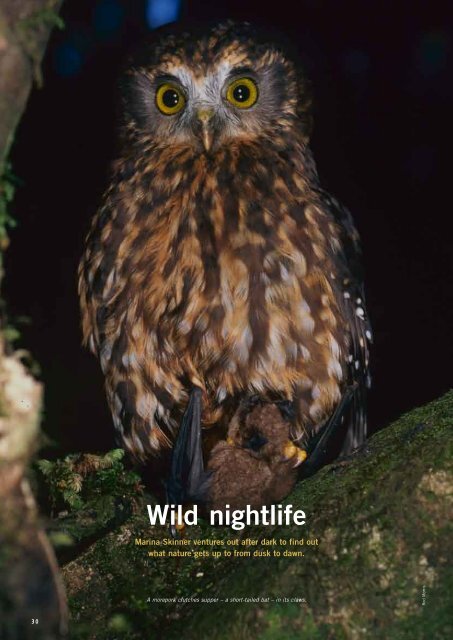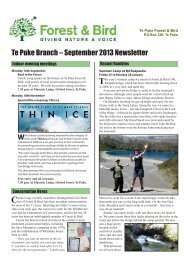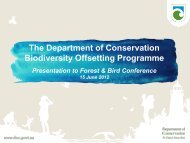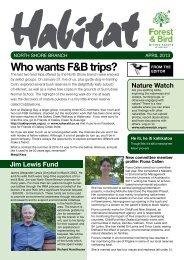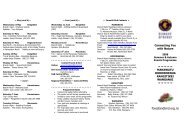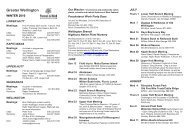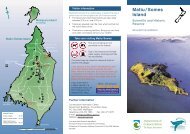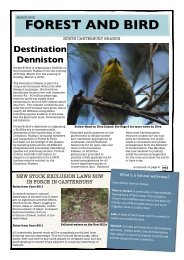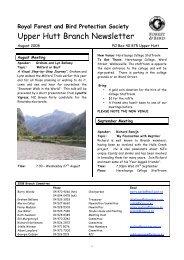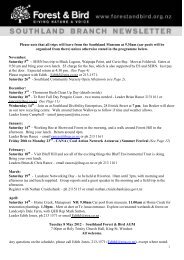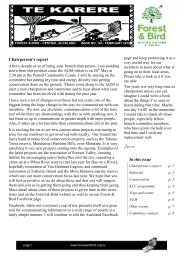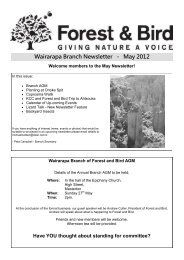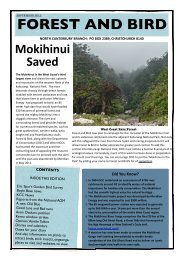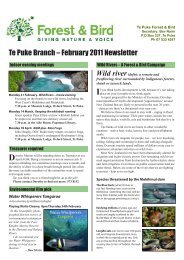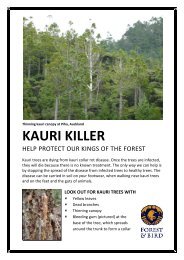Wild Nightlife (PDF version) - Forest and Bird
Wild Nightlife (PDF version) - Forest and Bird
Wild Nightlife (PDF version) - Forest and Bird
You also want an ePaper? Increase the reach of your titles
YUMPU automatically turns print PDFs into web optimized ePapers that Google loves.
30<br />
<strong>Wild</strong> nightlife<br />
marina Skinner ventures out after dark to find out<br />
what nature gets up to from dusk to dawn.<br />
A morepork clutches supper – a short-tailed bat – in its claws.<br />
Rod Morris
When humans turn in for the night, many of our wild<br />
creatures are just waking up. We hardly ever see some<br />
of our native animals because they keep very different<br />
hours from us. But break your routine <strong>and</strong> venture into the bush<br />
or explore the coast at night, <strong>and</strong> you’ll find a whole lot of nightlife<br />
going on.<br />
it seems odd to us humans, poorly adapted to coping in the<br />
dark, that our wilderness areas can be just as busy at night as<br />
they are in the day, but the night’s cooler temperatures, dampness<br />
<strong>and</strong> cover from sharp-eyed predators provides ideal conditions for<br />
many native species.<br />
A North Isl<strong>and</strong> brown kiwi hunts for freshwater crayfish.<br />
The late bird catches the worm<br />
the kiwi is New Zeal<strong>and</strong>’s best-known nocturnal bird, navigating in<br />
the dark with its excellent senses of smell <strong>and</strong> touch. You’d expect<br />
it to have large eyes – like owls – but instead it relies on its nostrils<br />
at the end of its bill <strong>and</strong> well-developed smell centre in the brain.<br />
the kakapo also forages on the ground at night for fruit <strong>and</strong><br />
seeds <strong>and</strong> has a good sense of smell. it is the only nocturnal<br />
parrot in the world – <strong>and</strong> the only flightless one. it’s also critically<br />
endangered, with just 91 known to exist.<br />
the large eyes of the morepork (ruru) point to their terrific<br />
eyesight. they have large ear holes, too, giving them superb<br />
hearing. they are highly effective night-time predators, flying<br />
silently <strong>and</strong> sneaking up on wetas <strong>and</strong> other insects.<br />
some native birds are most active at dawn <strong>and</strong> dusk, including<br />
weka, kaka <strong>and</strong> blue ducks, or whio.<br />
many seabirds are nocturnal, <strong>and</strong> some come ashore after<br />
dark during nesting <strong>and</strong> build burrows for their chicks. Little blue<br />
penguins also return to l<strong>and</strong> after dark when fewer l<strong>and</strong> predators<br />
are around.<br />
Young female kakapo on Codfish Isl<strong>and</strong>.<br />
Rod Morris<br />
Rod Morris<br />
Inky depths<br />
As most fishermen know, many sea creatures are more active<br />
at night than during the day. sea creatures that feed at night<br />
include s<strong>and</strong>fish, sea urchins, crayfish, sea worms, spider crabs,<br />
seahorses, tube anemones <strong>and</strong> feather stars <strong>and</strong> brittle stars –<br />
relatives of starfish.<br />
some fish “slip on their pyjamas” before they turn in for the<br />
night. Pink maomao are a bright “Barbie” shade of pink during the<br />
day, but when the sun sets they rest on the seabed in paler, mottled<br />
nightwear to blend in with their surroundings.<br />
squid sink to the bottom of the ocean during the day,<br />
swimming nearer the surface as night falls to feed on crustaceans<br />
<strong>and</strong> small fish.<br />
many fish sleep resting on the seabed at night; whales are also<br />
night-time sleepers but they rest on the surface. in the 1840s<br />
european settlers complained about being kept awake at night by<br />
southern right whales blowing in Port Nicholson.<br />
Under the cover of darkness there is a mass migration of<br />
microscopic zooplankton, as billions of them rise from the ocean<br />
depths to feed on phytoplankton. sometimes the night-time<br />
sea surface sparkles from the “fairy lights” of billions of bioluminescent<br />
plankton.<br />
Holy flying bats<br />
New Zeal<strong>and</strong> has two<br />
different types of bat – the<br />
long-tailed <strong>and</strong> shorttailed<br />
bat. they both use<br />
echo-location to find their<br />
way around in the dark.<br />
Long-tailed bats are active<br />
between dusk <strong>and</strong> dawn<br />
<strong>and</strong> venture outside the<br />
forest canopy. the shorttails<br />
wait until it is properly<br />
dark <strong>and</strong> stick to the forest<br />
canopy, feeding on insects,<br />
fruit <strong>and</strong> nectar.<br />
Short-tailed bats feed on the ground.<br />
In the undergrowth<br />
Glow worms are the glitterati of the bush, though the less-thanglamorous<br />
reality is that they’re simply the larvae of flies. their bioluminescent<br />
glow attracts small insects, which fly into the larvae’s<br />
sticky threads hanging from cave roofs or underneath damp banks.<br />
the larva pulls in its supper on the line. Female adults keep up<br />
their natural glow to attract a mate.<br />
the mosquito’s whine is not a good omen for a restful night,<br />
<strong>and</strong> New Zeal<strong>and</strong> has 16 mosquito species, including four that are<br />
introduced. only the females bite humans <strong>and</strong> other mammals –<br />
the males stick to plant juices.<br />
Glow worms’ sticky threads dangle from a bank.<br />
www.forest<strong>and</strong>bird.org.nz forest & bird • november 2008 31<br />
Rod Morris Rod Morris
Rod Morris<br />
Rod Morris<br />
Rod Morris<br />
A Hochstetter’s giant l<strong>and</strong> snail sucks up an earthworm.<br />
Powelliphanta snails are not easy to find in the bush, despite<br />
their massive dimensions – their shells are about nine centimetres<br />
in diameter <strong>and</strong> they weigh up to 90 grams, the same as a female<br />
tui. the carnivorous snails live under leaf litter or logs <strong>and</strong> are on<br />
the move at night looking for earthworms <strong>and</strong> slugs to snack on.<br />
many spiders are active at night, with the orb-web spider<br />
spinning <strong>and</strong> repairing its necklace-like web in the dark, <strong>and</strong> water<br />
spiders catching night-flying insects.<br />
most cockroaches sprung indoors when a light is turned on at<br />
night are introduced species, but New Zeal<strong>and</strong> also has about 25<br />
native cockroaches, which are also nocturnal <strong>and</strong> are even found in<br />
alpine areas.<br />
Crickets, our large puriri moths <strong>and</strong> huhu beetles <strong>and</strong> of course<br />
our weta species are also all native creatures with a busy nightlife.<br />
A Puriri moth in Pureora forest.<br />
on the hop<br />
All four of New Zeal<strong>and</strong>’s native frog species are nocturnal <strong>and</strong><br />
hide under rocks, logs <strong>and</strong> plants during the day. they’re not so<br />
fond of water as introduced frogs, <strong>and</strong> three of the species stick to<br />
the forests. Critically endangered Archey’s frogs can climb several<br />
metres into trees at night to forage.<br />
A male Archey’s frog carries froglets on its back.<br />
Creeping about<br />
many skinks <strong>and</strong> geckos are nocturnal or active at dusk <strong>and</strong> dawn.<br />
they were easy meals for night-feeding kiore <strong>and</strong>, later, europeanintroduced<br />
rats <strong>and</strong> mice, <strong>and</strong> many skinks <strong>and</strong> geckos have<br />
become extinct or are in serious decline.<br />
tuatara are in a reptile class of their own. they feed on insects,<br />
lizards <strong>and</strong> frogs at night but sometimes come out of their burrows<br />
during the day to bask in the sun.<br />
In the shallows<br />
many native freshwater fish are nocturnal, probably to avoid birds<br />
such as shags <strong>and</strong> herons. Long-finned <strong>and</strong> short-finned eels<br />
usually hide under rocks or riverbanks during the day <strong>and</strong> come out<br />
at night to hunt small fish, snails <strong>and</strong> insect larvae using their good<br />
sense of smell. Freshwater crayfish, or koura, which live in our<br />
lakes <strong>and</strong> streams, also come out at night to feed.<br />
out for the evening<br />
many native plants put on their best show at night to attract the<br />
moths <strong>and</strong> other insects that pollinate them. New Zeal<strong>and</strong> has<br />
relatively few native day-flying butterflies, moths <strong>and</strong> bees, so many<br />
New Zeal<strong>and</strong> plants have evolved strong scents to attract nightflying<br />
moths. mahoe, the easter orchid <strong>and</strong> some pittosporums<br />
have small flowers that are strongly perfumed at night.<br />
night prowlers<br />
Like any master criminal, the most devastating introduced pests<br />
– possums, rats, stoats, weasels, ferrets <strong>and</strong> cats – operate under<br />
cover of darkness. they have wiped out entire species during their<br />
colonisation of New Zeal<strong>and</strong>, <strong>and</strong> still endanger many native birds<br />
<strong>and</strong> invertebrates. even the once-popular night-time garden visitor,<br />
the hedgehog, is no longer considered endearing <strong>and</strong> harmless,<br />
with studies showing they eat lizards <strong>and</strong> native bird eggs on their<br />
nocturnal jaunts.<br />
32 forest & bird • november 2008 www.forest<strong>and</strong>bird.org.nz<br />
Rod Morris
Night wonderl<strong>and</strong><br />
It’s happy hour at Wellington’s Karori <strong>Wild</strong>life sanctuary.<br />
As dusk falls, dozens of kaka are toasting each other with<br />
sugar water at the bird feeder. they’ll be back at dawn for<br />
another shot of the syrup that’s an acceptable alternative to<br />
the nectar they would slurp in the wild.<br />
squawking kaka are the rowdiest creatures visitors hear on<br />
a night tour. the dusk songs of hihi, tui <strong>and</strong> grey warblers are<br />
followed by hooting moreporks. We’re not lucky enough to see<br />
a kiwi but the shrill call of a male tells us they’re out on this<br />
rainy night.<br />
A large female tuatara sits outside her burrow for as long<br />
as we care to admire her, but it is too wet for us to venture<br />
into the old gold mine where cave wetas hang out.<br />
the highlight of the night<br />
tour is venturing through<br />
a glow worm wonderl<strong>and</strong>.<br />
their fairy lights twinkle<br />
deep into the bush beside<br />
the track. there’s something<br />
slightly spooky but completely<br />
magical about venturing into<br />
the forest at night.<br />
Sanctuary By Night tours<br />
are held at Karori <strong>Wild</strong>life<br />
Sanctuary every night except<br />
Christmas Day; tours start 30<br />
minutes before sunset,<br />
$55 adults, $30 children, www.sanctuary.org.nz<br />
Royal <strong>Forest</strong> <strong>and</strong> <strong>Bird</strong> Protection Society<br />
CONSERVATION CALENDAR 2009<br />
Conservation Calendar<br />
New Zeal<strong>and</strong><br />
Conservation Calendar<br />
Stunning photos of New Zeal<strong>and</strong>’s native ora <strong>and</strong> fauna taken<br />
by some our leading nature photographers. Envelope supplied;<br />
weight less than 200 gms for economical posting.<br />
$ 15 99<br />
ROYAL FOREST AND BIRD PROTECTION SOCIETY | 2009<br />
By purchasing this calendar you are contributing to conservation work in New Zeal<strong>and</strong><br />
includes post<br />
<strong>and</strong> packaging<br />
Nocturnal w<strong>and</strong>erings<br />
eNtomoLoGist <strong>and</strong> <strong>Forest</strong> & <strong>Bird</strong> President Peter<br />
maddison gathers his fellow night walkers about an hour<br />
before dusk to inspect the insect life. Before dark they will<br />
usually see a few ants crawling on tree trunks or the odd<br />
beetle under leaf litter.<br />
But once dusk falls, the scene changes, as spiders, slugs,<br />
tiny snails <strong>and</strong> cockroaches stretch their legs after a hard<br />
day’s rest.<br />
As it gets darker, tree wetas rise from their daytime beds<br />
in tree holes <strong>and</strong> climb to the young leaves <strong>and</strong> flowers for a<br />
midnight feast.<br />
Looper caterpillars emerge from leaf litter <strong>and</strong> scale the<br />
kawakawa bushes to leave their signature holes in the leaves.<br />
Crane flies – which look<br />
like winged daddy longlegs –<br />
<strong>and</strong> other insects love humid<br />
nights, <strong>and</strong> they’re even<br />
happier if it rains.<br />
Flat worms – some brilliant<br />
blue or wild yellow <strong>and</strong> up to<br />
12 centimetres long – seek<br />
out tiny insects to eat. slaters,<br />
or woodlice, ferret in leaf<br />
debris.<br />
Peter maddison’s Auckl<strong>and</strong><br />
night walks are $5 adults<br />
<strong>and</strong> children. To book,<br />
contact Kay Lindley, 09 837 8820 or kay@healthwest.co.nz<br />
Royal <strong>Forest</strong> <strong>and</strong> <strong>Bird</strong> Protection Society<br />
NEW ZEALAND<br />
CONSERVATION DIARY 2009<br />
Gentianella sp., Kahurangi National Park (Kay Jackson)<br />
This beautifully produced diary includes photographs of New<br />
Zeal<strong>and</strong> l<strong>and</strong>scapes, plants <strong>and</strong> wildlife. It includes ‘week to view’<br />
pages <strong>and</strong> is spiral bound so it will lie at when open.<br />
$ 24 99<br />
includes post<br />
<strong>and</strong> packaging<br />
Both calendar <strong>and</strong> diary are available now. Send orders with cheque <strong>and</strong> delivery details to:<br />
Craig Potton Publishing, PO Box 555, Nelson. Phone 03-548-9009. Fax 03-548-9456.<br />
Email: info@cpp.co.nz. To order by credit card, refer to the <strong>Forest</strong> <strong>and</strong> <strong>Bird</strong> website: www.forest<strong>and</strong>bird.org.nz<br />
www.forest<strong>and</strong>bird.org.nz forest & bird • november 2008 33<br />
SEPTEMBER 2009<br />
7 MONDAY<br />
8 TUESDAY<br />
WEDNESDAY<br />
9<br />
10<br />
THURSDAY<br />
FRIDAY<br />
11<br />
SATURDAY<br />
12<br />
SUNDAY<br />
13<br />
SEPTEMBER 2009<br />
M T W T F S S<br />
1 2 3 4 5 6<br />
7 8 9 10 11 12 13<br />
14 15 16 17 18 19 20<br />
21 22 23 24 25 26 27<br />
28 29 30<br />
OCTOBER 2009<br />
M T W T F S S<br />
1 2 3 4<br />
5 6 7 8 9 10 11<br />
12 13 14 15 16 17 18<br />
19 20 21 22 23 24 25<br />
26 27 28 29 30 31<br />
Rod Morris


